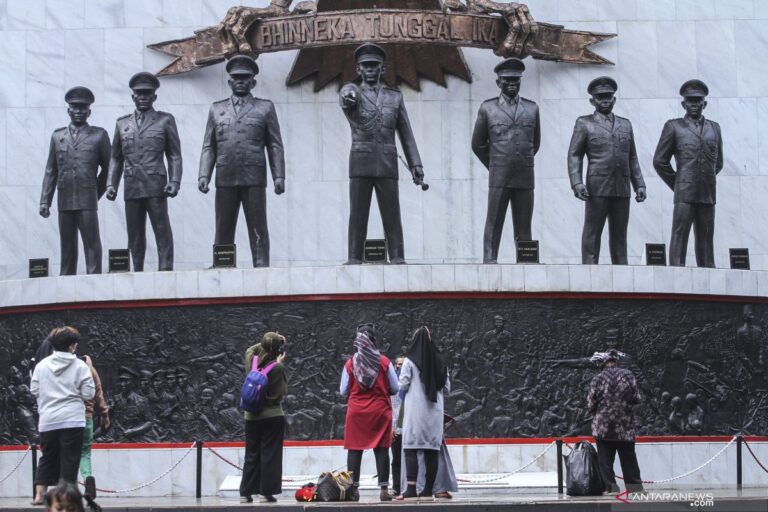
Jakarta (ANTARA) – Each country has troops tasked with protecting its sovereignty from various threats, both internal and external. Indonesia also has the Indonesian National Army (TNI), an institution whose role is at the forefront of maintaining the country’s security and integrity.
As a form of respect for the service and devotion of the TNI, the birthday of the TNI is celebrated every October 5. This date marks the birth of the Indonesian military institution which dates back to the early days of independence.
Read also: Defense Minister, TNI commander and national police chief release contingents for Bastille Day
Starting as People’s Security Agency (BKR)
After the proclamation of independence on 17 August 1945, Indonesia was not completely free from the colonial threat.
The Preparatory Committee for Indonesian Independence (PPKI) formed a number of bodies on 22 August 1945, one of which was the People’s Security Agency (BKR). This agency was established as a forum for combatants to maintain safety of people in the critical post-proclamation situation.
Initially, on August 19, 1945, the PPKI planned to form a national army. However, this decision changed and BKR was formed, led by Dr. Sutomo Sjahrir.
Read also: President checks availability of TNI contingent to take part in French Bastille Day march
Establishment of the People’s Security Army (TKR)
The threat of the return of the Dutch made it necessary for the Indonesian government to officially form a national army. This decision was also supported by the wishes of BKR members.
Until October 5, 1945, the People’s Security Army (TKR) was officially formed which became the originating moment to commemorate the anniversary of the TNI.
The day after the formation of TKR, President Soekarno appointed Suprijadi, a figure in the PETA rebellion in Blitar, as minister of popular security and top leader of TKR. However, since Suprijadi never showed up, the position was finally replaced.
At the TKR conference in Yogyakarta on 12 November 1945, Colonel Soedirman was elected supreme leader and then appointed commander-in-chief of the TKR on 18 December 1945.
Read also: Prabowo proud that TNI contingent took part in Bastille Day parade in Paris
Change of TKR to TRI
The Indonesian military organization’s journey continues to undergo restructuring. On January 8, 1946, the People’s Security Army changed its name to the People’s Salvation Army according to Government Decree No. 2 of 7 January 1946.
Several weeks later, on January 26, 1946 to be precise, the government again decided to change the name to the Indonesian Republic Army (TRI). This decision is based on what was announced in government decree no. 4/DS 1946.
This step was taken so that the Indonesian military structure would comply with international standards. The government also formed a Great Committee for the Organization of Military Organizations to improve military organization.
The committee reported the results of its work on May 17, 1946, concerning the design and form of the Ministry of Defense and Army, the transition from the TKR to the TRI, the strength and organization, as well as the position of the troops, ranks and bodies of people’s struggle.
Accordingly, on May 25, 1946, President Soekarno inaugurated the officials of the Headquarters and the Ministry of Defense. General Sudirman became the representative of all nominees by swearing oath to members of the army leadership.
Read also: Rafters: TNI AU sets five priorities in serving the nation
The birth of the Indonesian National Army (TNI)
Even though the TRI was established, there are still often misunderstandings with other people’s fighting bodies. To overcome this problem, President Soekarno formalized the unification of the TRI with the popular struggle bodies on 3 June 1947 to become the Indonesian National Army (TNI).
General Soedirman was also appointed head of the TNI alongside a number of other military figures, including Lieutenant General Oerip Sumohardjo, Commodore Suryadarma and Rear Admiral Nazir. Since then, the TNI began to be organized into three dimensions: army, navy and air force.
Also read: TNI says today’s anniversary rehearsals went well
APRI’s journey to becoming ABRI
After Indonesia became the United Republic of Indonesia (RIS) in December 1949, the TNI was merged with the KNIL and became the RIS War Force (APRIS). However, after the dissolution of RIS in 1950, this organization changed to the Indonesian Armed Forces (APRI).
To increase effectiveness, in 1962 APRI was merged with the National Police and became the Armed Forces of the Republic of Indonesia (ABRI).
However, this unification eventually gave rise to dynamics, especially when the September 30 Movement/PKI incident occurred. However, ABRI is still able to play its role in maintaining national defense and security.
Read also: Today the Constitutional Court abandoned the formal revision of the TNI Law and the BUMN Law
Returning to the TNI
The reform events of 1998 brought major changes, including the separation of ABRI into two institutions, namely TNI and Polri. On April 1, 1999, the TNI officially reestablished itself as a national defense force.
Since its inception, the TNI has played the role of the people’s army, revolutionary army and national army. In the period 1945–1949, the TNI also faced various threats, ranging from internal rebellions, such as PKI Madiun and Darul Islam, to Dutch military aggression with much more modern weapons.
With this long journey, October 5 is not only a celebration of the anniversary of the TNI, but also a reminder of the history of the struggle and strengthening of the TNI’s commitment to safeguarding the sovereignty of the nation.
Read also: TNI AU’s SPPG kitchen serves 32 thousand MBG beneficiaries every day
Reporter: Putri Atika Chairulia
Publisher: Suryanto
Copyright © ANTARA 2025
Automatic retrieval of content, crawling or indexing by artificial intelligence on this website is strictly prohibited without written permission from ANTARA news agency.



